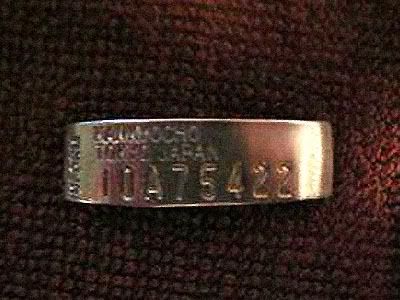Post by 2Poppa on Mar 6, 2008 13:30:08 GMT -5
Impossible Odds?
RULEVILLE, Miss. — The band was different, unlike anything Freddie Scott had ever seen. And likely neither had any other American hunter, for that matter.

Fred Scott displays the unusual duck band, which miraculously made its way from Japan to Mississippi.
"It appeared to be stainless steel, and every band I have ever seen was aluminum in appearance." Scott said. "I showed it to my son and we were both in disbelief at what we were seeing; I didn't know what to make of it."
Furthermore, Scott couldn't believe the inscription on the band; he thought it was a joke.
"It is still quite unbelievable that a pintail could fly that many miles in his lifetime; and how he ended up my hands on a farm in Ruleville, Miss., is beyond me," Scott explained.
Biologists say the band Scott recovered on January 3, 2008, from a drake northern pintail near Ruleville, was banded in Japan.
The man with the band!
Freddie Scott doesn't possess a lanyard full of bands; he readily admits he has only killed one other banded waterfowl.
He is a dedicated hunter who drives across the width of the state of Mississippi from his LaGrange, Ga., home to hunt ducks with his son, his daughter, and a close group of hunting buddies near Ruleville. A passionate hunter, the tone of his voice is genuine and comforting — he is just one of the boys.
"I have always enjoyed duck hunting; it means even more now that I can hunt with my children," Scott said in his slow Southern drawl. "I wish my son would have shot that pintail — that would have been amazing. At least he was there with me... that means a lot."
As soon as he and his son noticed this duck was unlike the others, he started the investigation.
"I immediately called a hunting buddy of mine who couldn't believe what I was describing to him," Scott said. His friends reacted like most people would when faced with such an outrageous story. "I got ridiculed to death. Nobody believed me." On January 8, after receiving quite a ribbing from all of his friends, and a sarcastic "there ain't no way," from one of the guys at Mack's Prairie Wings (a leader in everything waterfowl out of Stuttgart, Ark.), he was fed up.
It was time to confirm the origin of this rare piece of metal.
Scott dialed 411 on his cell. When the operator answered, he asked for the phone number for a waterfowl biologist in the state of Mississippi. The operator on the other end asked Mr. Scott to be more specific.
"Get me in touch with a biologist in Jackson, Mississippi," he said.
After a few clicks and bit of silence, a phone rang in the office of the USDA Natural Resources Conservation Service in Pearl, Miss.; the call was then forwarded down the hall to USDA NRCS Biologist Jeffery Lee.
Seriously, Japan?

A closer look at the duck band itself.
Lee listened as Scott told him about the hunt he had with his son that day and of the banded drake pintail, the last of only three ducks bagged that morning. He became more enthralled as Scott gave him the numbers 10A75422 from the band, and the almost unbelievable words inscribed above it: Kankyocho-Tokyo, Japan.
Lee was the first of many biologists and conservationists who would hear Scott's story, and it was Lee who would eventually find the band's true origin, verifying its authenticity through emails and phone calls with biologists, researchers, and conservationists from around the globe.
His first call was to Randy Wilson, a United States Fish and Wildlife Service (USFWS) Biologist with the USFWS Migratory Bird Office in Jackson, Miss. Wilson agreed to check his sources and find out if this were consistent with a Japanese bird band, and if one had ever been recovered in the Mississippi Flyway.
Lee then called Dr. Richard Kaminski, a professor of wildlife at Mississippi State University, who pointed him to the foremost authority in conservation bird bands in the United States, the Patuxent Bird Banding Laboratory, where Lee spoke with Dr. Paul Padding and Mr. Terry Liddick.
Both biologists thought the pintail was indeed banded in Japan, and gave Lee the contact information for the Yamashina Institute of Ornithology's Bird Banding Research Center, located in Konoyama, Japan.
Liddick would state in an email that in his three years at the lab, he had never been asked to verify a Japanese band — he knew it had to be rare.
Lee forwarded the recovery information data sheet via email to the Japanese Bird Banding Institute that afternoon.
"I could hardly sleep that night." Lee said. "I couldn't wait to get back to the office the next morning."
When Lee checked his email, what had at first been thought near impossible was confirmed: The drake northern pintail was in fact banded on Hyoko Lake near Niigata, on the northwestern coast of Japan.
The pintail had been banded on February 12, 2000, by Ryuhei Honma, a bird banding specialist for the Japanese Bird Banding Association, as part of an ongoing research project conducted by the Bird Banding Research Center.
"I tried to find out more about the research they were doing in Japan." Lee continued. "The question I really wanted to know was if they had ever recovered a bird band in the Mississippi Flyway before."
Keiko Yoshiyasu of the Japanese Bird Banding Association confirmed other birds banded in Japan had been recovered in five U.S. states, Alaska, California, Washington, Oregon, and Utah, with Utah being the farthest east any bird banded in Japan had traveled into the North America.
Scott was amazed that he was actually in possession of one of the rarest bird band recoveries in history.
"I have heard all of the Japanese duck jokes I can stand." Scott laughed as he continued. "Now I can have the last laugh."
When asked what he was going to do with this rare piece of history, Scott said. "I am going to lock this band away in the safe deposit box for future generations of my family to hold and to talk about. How many duck hunters can say they have killed a duck banded in Japan?"









 What a treasure that lucky hunter got,,
What a treasure that lucky hunter got,,



 -KT
-KT
